
The Dawoodi Bohras are a religious denomination within the Ismā'īlī branch of Shia Islam. They number approximately one million worldwide and have settled in over 40 countries around the world. The majority of the Dawoodi Bohra community resides in India, with sizable congregations in Pakistan, Yemen, East Africa, and the Middle East. They also have a growing presence in Europe, North America, and Australia. The present leader is the 53rd al-Dai al-Mutlaq, Mufaddal Saifuddin who assumed office in January 2014.

Mohammed Burhanuddin was the 52nd Dā'ī al-Mutlaq of Dawoodi Bohras. He led the community for 49 years in a period of social, economic, and educational prosperity; strengthened and re-institutionalized the fundamental core of the community's faith; revived its culture, tradition, and heritage. In successfully achieving coexistence of traditional Islamic values and modern Western practices within the community, Burhanuddin completed the work his predecessor Taher Saifuddin had started. Burhanuddin was presented the highest national civilian honors of the states of Egypt and Jordan recognising his revivalism and restoration efforts. He was known in Arab countries as Azamat us-Sultan. Owing to extensive travels for community reach-out, he was the first Dā'ī al-Mutlaq to visit Europe, Australia, and America.
The Musta‘lī are a branch of Isma'ilism named for their acceptance of al-Musta'li as the legitimate nineteenth Fatimid caliph and legitimate successor to his father, al-Mustansir Billah. In contrast, the Nizari—the other living branch of Ismailism, presently led by Aga Khan IV—believe the nineteenth caliph was al-Musta'li's elder brother, Nizar. Isma'ilism is a branch of Shia Islam.

Taher Saifuddin, also known as Tahir Sayf al-Din, was the 51st and longest serving Da'i al-Mutlaq of the Dawoodi Bohras. Saifuddin adapted the modernisation in Western and European ideas, and established its benefits for the Bohras, whilst still steeped in the traditions and the culture of the community's Fatimid heritage. Saifuddin laid substantial groundwork in terms of philanthropy, education, entrepreneurship, social outreach, political outreach, and community upliftment upon which his successors, Mohammed Burhanuddin and Mufaddal Saifuddin, continued to build, resulting in an unprecedented era of prosperity among the Dawoodi Bohras.
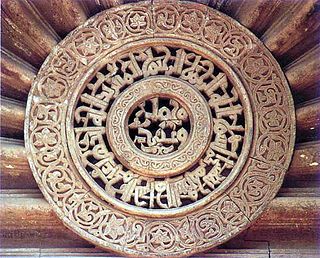
The term Da'i al-Mutlaq literally meaning 'the absolute, or unrestricted, missionary', is the most senior spiritual rank and office in Tayyibi Isma'ilism. The Da'i al-Mutlaq has headed the Tayyibi community since the seclusion of the 21st Tayyibi Imam, at-Tayyib Abu'l-Qasim, traditionally placed in 528 AH/1134 AD.
Tayyibi Isma'ilism is the only surviving sect of the Musta'li branch of Isma'ilism, the other being the extinct Hafizi branch. Followers of Tayyibi Isma'ilism are found in various Bohra communities: Dawoodi, Sulaymani, and Alavi.

Mufaddal Saifuddin is the spiritual leader, the 53rd Da'i al-Mutlaq of one million Dawoodi Bohras, a subgroup of the Tayyibi, Mustaali, Ismaili Shia branch of Islam. He is the second son of the 52nd Da'i al-Mutlaq, Mohammed Burhanuddin, whom he succeeded in 2014. He is the Chancellor of Aligarh Muslim University and Jamia Miliya Islamia University situated in India. He has led a number of cultural, social, and economic initiatives. In Islamic Cairo, he rebuilt shrines of the Ahl al-Bayt and led the restoration of medieval Fatimid architecture, notably Al-Anwar Mosque, Al-Aqmar Mosque, Al-Juyushi Mosque, and Lulua Mosque. In Yemen, he has spearheaded several campaigns to improve socio-economic conditions of the inhabitants of the Haraaz region, introducing sustainable agricultural systems, improving local infrastructure and providing equal access to education for children.

Syedna Abdullah Badruddin bin Syedna AbdulHusain Husamuddin ; born 11 July 1846) was an Indian-born religious leader, and the 50th Da'i al-Mutlaq of the Dawoodi Bohra sect. He was the son of Syedna AbdulHusain Husamuddin, whose family lineage can be traced back to Syedi Fakhruddin Shaheed. When the 49th Da'i al-Mutlaq Syedna Mohammed Burhanuddin did nass upon him, all those people who used to say, "After Syedna Mohammed Burhanuddin, the sect would come to an end", could not believe their eyes.
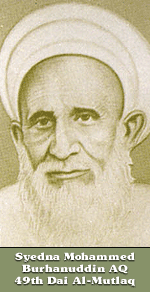
Mohammed Burhanuddin born 18 November 1840 in Surat, India – died 21 February 1906, was 49th Da'i al-Mutlaq of the Dawoodi Bohra sect. He was the son of the 47th Da'i al-Mutlaq Abdul Qadir Najmuddin, who belongs to the family lineage of Fakhruddin Shaheed. After the death of the 48th Da'i al-Mutlaq Abdul Husain Husamuddin the helm of the Dawoodi Bohra sect came into his hands. He led the community out of a period of indebtedness, disorganization and lack of development within the sect.
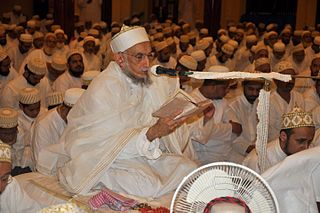
Abu Taher Khuzaima Qutbuddin was the son of the 51st Da'i al-Mutlaq, half brother of the 52nd Da'i and a Mazoon of the Dawoodi Bohras, a subgroup within the Mustaali, Ismaili Shia branch of Islam. Qutbuddin was appointed as Mazoon by the Da'i al-Mutlaq, Syedna Muhammad Burhanuddin in 1965.
The 52nd Da'i al-Mutlaq of the Dawoodi Bohras, Mohammed Burhanuddin died in January 2014. As per the tenets of the sect each predecessor is required to nominate his successor prior to his death. Following his death, a question on succession arose where two rival claimants emerged for the title of 53rd Dā'ī al-Mutlaq: his son, Mufaddal Saifuddin, and his half-brother, Khuzaima Qutbuddin, who was previously Mazoon of the Dawoodi Bohra.
Taher Fakhruddin is the 2nd Da'i al-Mutlaq of the Qutbi Bohras, a sect within Shia Islam. He is the son of Khuzaima Qutbuddin, the 53rd Syedna succession controversy. After the death of the 52nd Da'i al-Mutlaq, syedna Mohammed Burhanuddin, due to the succession controversy, one claimant emerged, Khuzaima Qutbuddin. Followers of Khuzaima Qutbuddin regard Taher Fakhruddin as a rightly appointed Da'i al-Mutlaq whereas followers of Syedna Mufaddal Saifuddin do not recognise him as the Da'i al-Mutlaq.
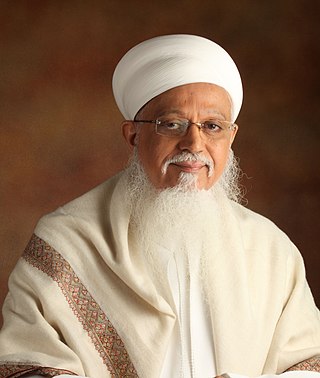
Mukasir al-Da'wat Shahzada Qaidjoher Ezzuddin is the eldest son of Mohammed Burhanuddin, the grandson of Taher Saifuddin, and elder brother of the incumbent 53rd Dai al-Mutlaq Mufaddal Saifuddin. He is one of the four rectors of Al Jamea tus Saifiyah.

Abdeali Saifuddin was the 43rd Da'i al-Mutlaq of the Dawoodi Bohra. He was the son of 41st Da'i al-Mutlaq Abduttayyeb Zakiuddin III and the brother of the 42nd Da'i al-Mutlaq Syedna Yusuf Najmuddin. He was a Dai, scholar and poet and one of the most venerated Dawoodi Bohra Dai's.

Syedna AbdulHusain Husamuddin bin Syedna Tayyeb Zainuddin was the 48th Da'i al-Mutlaq of the Dawoodi Bohra. He was born on the day of Ashura in 1239 AH/1823 AD and died on 27th Zilhijjat al-Haram 1308 AH/1891 AD in Ahmedabad, India.

Syedna Mohammed Badruddin was the 46th Da'i al-Mutlaq of the Dawoodi Bohra. He succeeded the 45th Da'i, Syedna Tayyeb Zainuddin, to the religious post. He was born in Bharuch in 1811. He was seven years old when his father Syedna Abde'Ali Saifuddin died. He was taken under the care of Syedna Mohammed Ezzuddin who brought him up and nurtured him for four years.

Aljamea-tus-Saifiyah is an Arabic academy dedicated to Islamic learning based in India, Pakistan, and Kenya. Established in Surat as Dars-e Saifeec. 1810 by Abde'Ali Saifuddin, it was after extensive renovation and expansion carried out by Taher Saifuddin and Mohammed Burhanuddin, the university gained prominence. Today, as holder of the office of Dāʿī al-Mutlaq, Mufaddal Saifuddin is the sole benefactor of the institute.
Risalah Arabic (رسـالـة) is the Arabic word for a treatise or philosophical prose within Islam. In Tayyibi Isma'ilism, Rasāʾil Ramaḍāniyya refers to the works composed by the Da'i al-Mutlaq for the most part during the month of Ramadan.
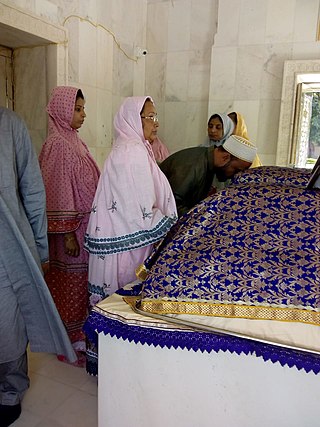
Bawa Mulla Khan was a Dawoodi Bohra saint who lived in the 18th century in India. He died on the 29th of Shawwal. His shrine (dargah) is in Rampura, Madhya Pradesh, India.






























